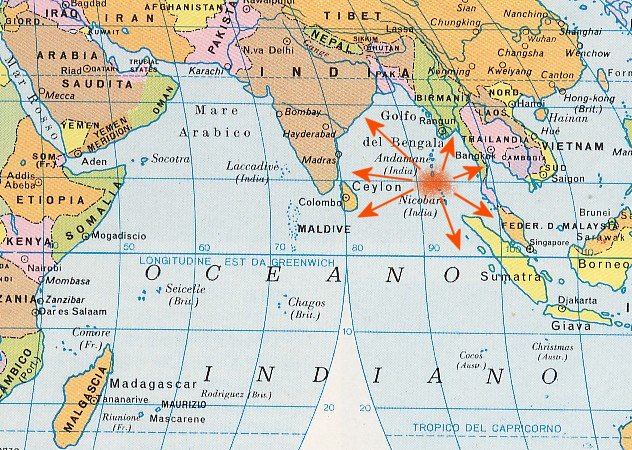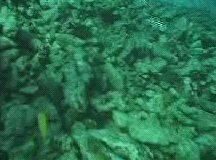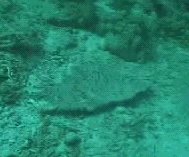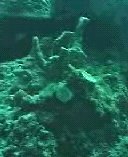|
Tsunami and coral reef..
(by Marco Angelozzi)
The day December 23 year
2004, in the north of the Macquarie Islands (near Australia) it
happen one of the strongest earthquakes that can be remembered in
the history of that angle of the planet. The magnitudo is 8,5 of the
Richter scale, a very high value and in the following hours there
are many arrangement shakes.
The Geology teaches that generally a strong earthquake doesn't cause
others of it and also for this motive nobody could imagine that
later as soon as three days there would be recorded, to around
3000km of distance, the most violent earthquake of the last 40
years..
On December 26 in fact it
happen an earthquake with epicentre in northwestern of the island of
Sumatra, in the backdrops of the Indian ocean, it frees an energy
equal to that that would be had with the explosion of 20000 atomic
bombs..
This event causes the move of the Earth of 3 cms in comparison to
its axle of rotation, a shortening of the day of 3 second
milionesimis, a move of the island of Sumatra of 30 mt toward
southwest and above all one of the more powerful tsunami ever
observed to man memory..
The tsunami, from the
Japanese “wave of the port”, can be caused, as in this situation,
from a strong submarine earthquake that upsets and it moves upward
very violently the column of impending water from the lower part.
This move produces a series of so that anomalous waves that can
spread for thousand kilometres with very high speed, up to reach the
dry land.
In opened sea the waves have a least height, as soon as 50 cms or
less, but when they reach lower backdrops the masses of water,
because of the attrition, decrease the speed of their run and they
also raise him up to 10 meters, as on December 26 happened, flooding
the dry land..
Before the waves get depressed on the coast there is a strong
backwash, the sea withdraws it for about ten meters and this is the
signal that water is about to invade the dry land.
The areas struck by the tsunami of December 26 have been Thailand,
India, the Sri Lanka, Indonesia, the Malesia, the Maldives and the
waves have also arrived in Africa, on the coasts of Somalia, Kenya
and Tanzania.

(Zones struck by
the tsunami. The red zone points out the probable point of departure
of the anomalous waves)

(Zones struck by
the tsunami. The red zone points out the probable point of departure
of the anomalous waves)
All the coral formations of
these zones, the richest of the globe as biodiversity (with around
1700 different kinds of fishes and 400 of madrepore) have harshly
been stricken from the destroying strength of the waves and on them
there are poured great quantities of mud, sand and refusals.
The waves of return that
have invaded the dry land have in fact dragged in water deposits,
refusals, poisons and hydrocarbons torn from the industries and from
the man residences. They are still few, to two months from the
event, the underwater surveys effected to know the state of the
flora and fauna, but they immediately result evident the great
quantities of sand that have covered the coral reefs..
This coverage can put to risk the survival of the same coral, in
fact it doesn't allow the algas zooxantelle that live inside of it
to receive the light of the sun and to effect the chlorophyllose
photosynthesis.


(Images drawn from
the Italian giornal “Il corriere della sera”: the anomalous wave
reaches the coast)
If this situation persisted
different months the algas they would risk to die, putting also in
serious difficulty the coral that he/she lives in symbiosis with
them, receiving important organic substances for the development and
for the construction of the barrier.
A solution could be that to
organize a plan of “cleaning” of the corals that involves numerous
and willing scuba divers making to literally return to the light
these wonder of the nature. We hope that the strong tides that are
present in a lot of of these zones can naturally polish up the
barrier and to contribute to the return of a situation of normalcy.
The strength of the waves
has caused besides the breakup of many branched corals, landslides
of portions of reef (even stop of 1-2 ms cubes eradicated by the
walls) with the accumulation of them on the backdrops, inclusive
those of the passes, that have decreased their depth of 2-3 meters
in some zones!
(the passes are of the small interruptions of the coral barrier that
connect the ocean with the inside sea to the atoll, through which
strong tides generally flow).



(Images of the
coral barrier struck by the tsunami, with fans and corals branched
broken)
The numerous destroyed
areas could have left besides the abundant tropical fauna of which
this area is rich without shelter, as for example the parrot fish
that is usual to use the hollow among the corals as mend for the
night. This fish nourishes him of algas that it tears from the
barrier with its horny beak and the zones where usual feed could
have been destroyed.
The lobster as other kinds
of shellfishes and tropical molluscs that hide him in the ravines of
the madrepores, could be found again without habitat and forced to
adapt again and to colonize other zones. The "barracuda", great
raider that can reach 2 meters length that it stirs at night in
flock during the day and hunting, needs to live in clear waters and
the movements caused by the tsunami could now create difficulty.
Which zones has been mostly
struck by the violence of the tsunami ?
The Asian area and
particularly the coral barriers of the islands Andamene and Nicobare
have mostly been reached by the violence of the anomalous waves.
Here numerous bushes of corals have been observed branched broken,
heaps of fragments, deposits in the backdrops and portions of
collapsed reef and partially covered of sand..
In the most distant areas,
reached by a smaller violence of the waters, the coral barriers seem
to have brought damages of smaller entity.
To the Maldives for instance, in base to the
preliminary study effected by the Marine Science
Group of the university in Bologna, the
damages would be more contained and they would represent only the 6%
of the whole coral system, recoverable in brief times.
In this case a function of
protection of the island of Sri Lanka is hypothesized. The island
would have braked the run of the anomalous waves and also the
particular conformation of the depths backdrops of the Maldive.
These are the effects that
the impact of the anomalous waves has directly produced and
indirectly on the natural environment of the coral barrier of the
Asian area. Which have been the direct effects of the arrival of the
tsunami on the sea fauna and earthling instead?
The results of the first
searches seem amazing. All the animals that had the possibility to
get further in hurry would have done it just before the arrival of
the anomalous waves reducing their losses to very low levels. As it
surely regards the sea fauna some fishes, molluscs and shellfishes
of small dimensions will have surely been beaten with deadly result
on the barrier but the majority of them will have perceived with
good advance the arrival of the masses of water. This thanks to
their acute senses, above all the ability to gain tall or low
frequencies that would have alerted them with good advance giving
them the permission to shelter in sure depht waters.
(Obviously the underwater
surveys have noticed that in some zones there is no more abundance
of fishes but this situation it is probably connected to the
alteration of the habitat, with the destruction of shelters and dens
in the barriers, referable situation to normalcy in brief times).
These “information” about
the arrival of so that anomalous situation have also been perceived
by the terrestrial animals, making them get further in territories
distant from the coasts and to greater heights on the level of the
sea.
In the Yala National Park
of the Sri Lanka in fact, house of hundreds of buffalos, elephants,
crocodiles, leopards, monkeys and other numerous mammals there has
not been found anybody trace of carcasses even if the tsunami in
that territories of the park has arrived with great violence
flooding it almost entirely!
Bibliographer:
- “Tsunami Survey
Expedition, Maldivian Coral Reefs, 2 weekses after” Marina Science
Group.
- “The risk tsunami” of L.
Bignami.
- Articles: “Tsunami, thing
has favorite the Maldives” and “You truth on the Maldives.”
- Article: “The sixth sense has saved all the animals.”
|
.gif)
![]()